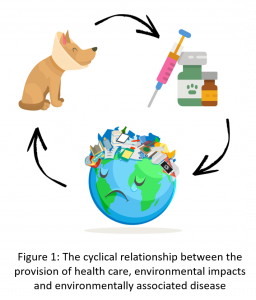The SAVE Guidebook Project: Procurement
In December 2020, the World Veterinary Association (WVA) released a position statement on the global climate change emergency and called on veterinarians and member associations to take immediate action on the topic.
‘Veterinarians, in their role as advocates for animal health and welfare and public health, have a responsibility to protect ecosystem health and demand action to minimize climate change. Globally, veterinarians actively contribute to climate change mitigation and environmental protection in many ways, including, but not limited to, advising on acceptable use of resources (feed, manure and animal by-products) and the appropriate handling of medical waste.’1
One of these proposed WVA actions was to ‘Urge[ ] members of the veterinary profession to research, review and adopt practices that minimize greenhouse gas emissions.’ Veterinarians, both current and future, are concerned about the health impacts associated with climate change and are particularly keen to minimize the environmental impact of their professional work.2,3 Similarly, veterinary clients expect their veterinarian to be knowledgeable about the health impacts of climate change and would be willing to pay more for services at a practice that has taken steps to minimize its own environmental footprint4. The objective of this guidebook is to support animal health professionals to achieve this goal, at least in part, by synthesizing information that can be used to inform sustainable procurement strategies.
The irony of the healthcare system

Healthcare is one of the most energy intensive service sectors and as a result, has a substantial environmental impact. The human healthcare system is estimated to produce ~4.5% of the worlds global greenhouse gas (GHG) emissions5-7. This number is both staggering and ironic as the magnitude of this impact has significant health impacts that healthcare seeks to prevent and address (figure 1). Additionally, these impacts are preventable. Recent studies have found that per capita GHG emissions were not correlated with the quality of health care suggesting that the industry may be able to reduce its environmental impact without compromising patient care.8
“If the health sector globally were a country, it would be the fifth [largest] emitter of greenhouse gases”
– Susan Wilburn, Health Care Without Harm
Relative to the human healthcare sector, far less is known about the environmental footprint of veterinary care. A recent literature review exploring resources for veterinarians to minimize the environmental impact of their clinical work found shockingly little peer-reviewed information on the topic.9 Despite this lack of profession specific resources, the review highlighted five physical and three behavioral themes that can help to inform veterinary clinics (figure 2). One of these themes is procurement.
Why procurement matters

Veterinary clinics, like human healthcare facilities, use a lot of supplies. By including sustainability into procurement policies, veterinary clinics have potential to significantly offset some of the impacts associated with the provision and delivery of their professional services. Procurement is a very ‘forward facing’ action that involves every member of a clinical team and efforts can be recognized by clients.
In order to make environmentally conscious procurement choices, purchasers would ideally evaluate product supply chains from sourcing and manufacturing to product packing and transportation. Life-cycle assessments (LCA) are systematic analyses of environmental impacts of products or services from creation to disposal. Veterinary clinics should consider these impacts from creation to disposal10-13 however, to individually assess and compare relevant sustainability data for all products and services procured by the clinic is a momentous undertaking. This task can be made easier by:
- Recognizing and understanding relevant third-party certifications
- Reviewing corporate sustainability practices from veterinary product suppliers
- Sharing information with colleagues
The veterinary profession is relatively small and as a collective, have the potential to incentivize suppliers to provide more sustainable products and services and, be transparent with available LCA data.13-15
Structure of this guidebook
The guidebook has three main sections. The first includes an overview of existing third-party product certifications that can help consumers identify individual items that have been reviewed by a credentialing organization. Identifying trustworthy labels and being able to understand and evaluate product or service claims will help purchasers select items with the lowest impacts and trade-offs. This section also introduces some procurement considerations for non-medical supplies routinely used in clinical practice.
The second section focuses on the sustainability policies and practices and claims of companies servicing veterinarians. These policies are not assessed or compared, rather synthesized so that guidebook users can quickly access this information to inform their procurement decisions.
The final section includes opportunities for veterinary staff to share their knowledge and experience. Two google forms provide guidebook readers to share experiences with products or companies that may be of interest to the broader veterinary community. Feedback will be aggregated and shared with readers in future versions of this guidebook.
There’s more to sustainability than just the environment
Sustainability broadly refers to achieving individual, societal, and environmental wellbeing in present and future generations. While the focus of the inaugural version of the guidebook is the environment, we hope to expand this guide to include additional information on topics like corporate social responsibility. Additionally, infusing sustainability is more than identifying the best product to purchase, it also includes considerations of how products are used and disposed of. Is the product made using recycled-content, helping to support recycling markets or, is the product easily recyclable at the end of useful life? What about transit and air travel of employees or clients? Can we locate, build and energize our practices to accomplish the largest number of co-benefits to all concerned? Or, what about the conditions of the facility where a product is manufactured, or the pay of the workers providing a service to your clinic? Individual, group and organizational behaviors are all important when it comes to procurement9, but are beyond the scope of this edition. Finally, veterinary clinics use a wide range of general (non-medical) services from a wide range of companies not included in this guidebook.
The intention of this guide is to begin the conversation and provide an initial framework for considerations of the sustainability or environmental impacts of the products and services most often used in veterinary practice. The goal is not to be perfect, but to begin to pay attention, knowing that our decisions are driving or furthering the market for goods and services with or without criteria that harms or helps the environment and our bottom line. The authors hope you will help us further these intentions to be well, while doing good.
References:
1 Association, W. V. WVA Position on the Global Climate Change Emergency. (2020).
2 Kramer, C. G., McCaw, K. A., Zarestky, J. & Duncan, C. G. Veterinarians in a Changing Global Climate: Educational Disconnect and a Path Forward. Frontiers in Veterinary Science 7, doi:10.3389/fvets.2020.613620 (2020).
3 Pollard, A. E. et al. Preparing Veterinarians to Address the Health Impacts of Climate Change: Student Perceptions, Knowledge Gaps, and Opportunities. J Vet Med Educ, e20190080, doi:10.3138/jvme-2019-0080 (2020).
4 Deluty, S. B. et al. Client Choice May Provide an Economic Incentive for Veterinary Practices to Invest in Sustainable Infrastructure and Climate Change Education. Front Vet Sci 7, 622199, doi:10.3389/fvets.2020.622199 (2020).
5 Lenzen, M. et al. The environmental footprint of health care: a global assessment. The Lancet Planetary Health 4, e271-e279, doi:https://doi.org/10.1016/S2542-5196(20)30121-2 (2020).
6 Pichler, P.-P., Jaccard, I. S., Weisz, U. & Weisz, H. International comparison of health care carbon footprints. Environmental Research Letters 14, 064004, doi:10.1088/1748-9326/ab19e1 (2019).
7 Watts, N. et al. The 2019 report of The <em>Lancet</em> Countdown on health and climate change: ensuring that the health of a child born today is not defined by a changing climate. The Lancet 394, 1836-1878, doi:10.1016/S0140-6736(19)32596-6 (2019).
8 Health Care Pollution And Public Health Damage In The United States: An Update. Health Affairs 39, 2071-2079, doi:10.1377/hlthaff.2020.01247 (2020).
9 Koytcheva, M. K. et al. A Systematic Review of Environmental Sustainability in Veterinary Practice. Topics in Companion Animal Medicine, 100550, doi:https://doi.org/10.1016/j.tcam.2021.100550 (2021).
10 McGain, F. & Naylor, C. Environmental sustainability in hospitals – a systematic review and research agenda. J Health Serv Res Policy. Oct;19(4):245-52. (2014)
11 Petre, M.-A. & Malherbe, S. Environmentally sustainable perioperative medicine: simple strategies for anesthetic practice. Canadian Journal of Anesthesia/Journal canadien d’anesthésie 67, 1044-1063, doi:10.1007/s12630-020-01726-0 (2020).
12 Unger, S. R., Campion, N., Bilec, M. M. & Landis, A. E. Evaluating quantifiable metrics for hospital green checklists. Journal of Cleaner Production 127, 134-142, doi:10.1016/j.jclepro.2016.03.167 (2016).
13 Campion, N. et al. Sustainable healthcare and environmental life-cycle impacts of disposable supplies: a focus on disposable custom packs. Journal of Cleaner Production 94, 46-55, doi:10.1016/j.jclepro.2015.01.076 (2015).
14 Seifert, C. & Guenther, E. Prevention is better than cure—Environmental management measures in hospitals. Corporate Social Responsibility and Environmental Management 26, 781-790, doi:10.1002/csr.1720 (2019).
15 World Health Organization. Healthy hospitals, healthy planet, healthy people: Addressing climate change in healthcare settings (2009).
